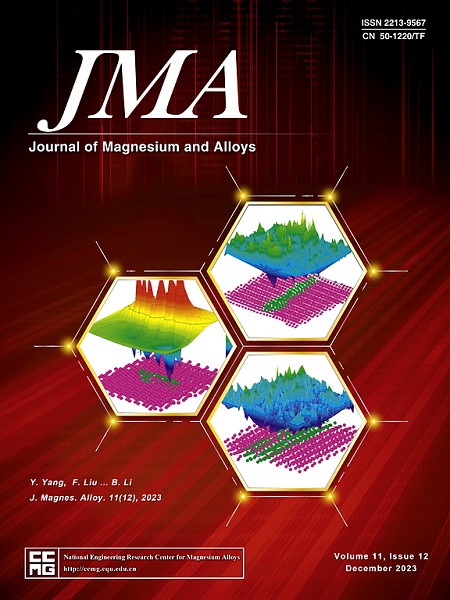A novel flame retardant strategy for molten magnesium alloys: The effect of the new protective gas C3H2F6 on EV33 alloy
IF 15.8
1区 材料科学
Q1 METALLURGY & METALLURGICAL ENGINEERING
引用次数: 0
Abstract
Resolving the ignition issue of magnesium alloys is essential for broadening their application scope. This research investigates the EV33 magnesium alloy, delving into an innovative flame-retardant strategy, with a specific focus on the impact of the novel protective gas C3H2F6 on the flame-retardant properties of the alloy. This paper unveils the morphological characteristics of the EV33 magnesium alloy surface in the absence of protective gas, while employing thermodynamic principles to establish the preferential reaction stages of the alloy, computing the residual stress of MgF2, and assessing the flame-retardant and antioxidative properties of C3H2F6. The study finds that under conditions without protective gas, the oxide film on the EV33 alloy surface is prone to cracking, which accelerates the ignition process of the alloy. Conversely, in an environment enriched with C3H2F6, the formation of a dense oxide film on the alloy surface significantly enhances its thermal stability and flame-retardant properties. This mechanism encompasses the formation of a secondary oxide film, where C3H2F6 accelerates the rapid development of this film, effectively repairing damage to the primary oxide film and inhibiting further diffusion of the oxidation reaction. Furthermore, this study elucidates the origin of oxide film rupture, showing that under conditions without protective gas, the precipitated phases and grain boundaries on the surface of the alloy induce the rupture of the oxide film, attributed to stress concentration phenomena occurring around the grain boundaries.

一种新型的熔融镁合金阻燃策略:新型保护气体C3H2F6对EV33合金的影响
解决镁合金的点火问题是扩大镁合金应用范围的必要条件。本研究以EV33镁合金为研究对象,探讨了一种创新的阻燃策略,重点研究了新型保护气体C3H2F6对EV33镁合金阻燃性能的影响。本文揭示了EV33镁合金在无保护气体条件下的表面形态特征,运用热力学原理建立了EV33镁合金的优先反应阶段,计算了MgF2的残余应力,评价了C3H2F6的阻燃和抗氧化性能。研究发现,在没有保护气体的条件下,EV33合金表面的氧化膜容易开裂,加速了合金的点火过程。相反,在富含C3H2F6的环境下,合金表面形成致密的氧化膜,显著提高了合金的热稳定性和阻燃性能。该机制包括二次氧化膜的形成,其中C3H2F6加速了该膜的快速发展,有效地修复了一次氧化膜的损伤,抑制了氧化反应的进一步扩散。此外,本研究阐明了氧化膜破裂的原因,表明在没有保护气体的条件下,合金表面的析出相和晶界导致氧化膜破裂,这是由于晶界周围发生应力集中现象。
本文章由计算机程序翻译,如有差异,请以英文原文为准。
求助全文
约1分钟内获得全文
求助全文
来源期刊

Journal of Magnesium and Alloys
Engineering-Mechanics of Materials
CiteScore
20.20
自引率
14.80%
发文量
52
审稿时长
59 days
期刊介绍:
The Journal of Magnesium and Alloys serves as a global platform for both theoretical and experimental studies in magnesium science and engineering. It welcomes submissions investigating various scientific and engineering factors impacting the metallurgy, processing, microstructure, properties, and applications of magnesium and alloys. The journal covers all aspects of magnesium and alloy research, including raw materials, alloy casting, extrusion and deformation, corrosion and surface treatment, joining and machining, simulation and modeling, microstructure evolution and mechanical properties, new alloy development, magnesium-based composites, bio-materials and energy materials, applications, and recycling.
 求助内容:
求助内容: 应助结果提醒方式:
应助结果提醒方式:


